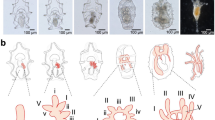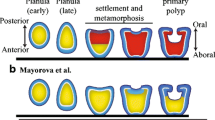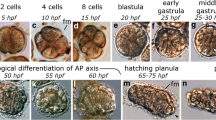Abstract
The life cycle of the moon jellyfish Aurelia coerulea consists of sessile polyp and free-swimming jellyfish stages. Strobilation is a polyp-to-jellyfish transition comprising sequential segment formation (segmentation), subsequent morphogenesis into ephyrae (young jellyfish), and detachment of the ephyrae. Cell proliferation is involved in metamorphosis in various animals. In the present study, we examined the relationship between cell proliferation and strobilation in A. coerulea. To visualize cell proliferation at various stages of strobilation, 5-bromo-2′-deoxyuridine labeling experiments were conducted, in which cell proliferation was distributed in the segments and prospective regions of the next segment during segmentation. Cell proliferation in segments continues during ephyra morphogenesis. Hydroxyurea, a cell-cycle inhibitor, was administered to investigate cell proliferation in animals at different stages of strobilation. In this study, hydroxyurea interrupted the initiation of strobilation, segmentation, and ephyra morphogenesis, but not ephyra detachment. This suggests that cell proliferation plays a crucial role in generating a new segment and constructing the ephyra body.







Similar content being viewed by others
References
Balcer LJ, Black RE (1991) Budding and strobilation in Aurelia (Scyphozoa, Cnidaria): functional requirement and spatial patterns of nucleic acid synthesis. Roux’s Arch Dev Biol 200:45–50. https://doi.org/10.1007/BF02457640
Brekhman V, Malik A, Haas B, Sher N, Lotan T (2015) Transcriptome profiling of the dynamic life cycle of the scypohozoan jellyfish Aurelia aurita. BMC Genom. https://doi.org/10.1186/s12864-015-1320-z
Chera S, Ghila L, Dobretz K, Wenger Y, Bauer C, Buzgariu W, Martinou JC, Galliot B (2009) Apoptotic cells provide an unexpected source of Wnt3 signaling to drive hydra head regeneration. Dev Cell 17:279–289. https://doi.org/10.1016/j.devcel.2009.07.014
Collins AG, Schuchert P, Marques AC, Jankowski T, Medina M, Schierwater B (2006) Medusozoan phylogeny and character evolution clarified by new large and small subunit rDNA data and an assessment of the utility of phylogenetic mixture models. Syst Biol 55(1):97–115. https://doi.org/10.1080/10635150500433615
Dawson MN, Jacobs DK (2001) Molecular evidence for cryptic species of Aurelia aurita (Cnidaria, Scyphozoa). Biol Bull 200:92–96
Fuchs B, Wang W, Graspeuntner S, Li Y, Insua S, Herbst EM, Dirksen P, Bohm AM, Hemmrich G, Sommer F, Domazet-Loso T, Klostermeier UC, Anton-Erxleben F, Rosenstiel P, Bosch TCG, Khalturin K (2014) Regulation of polyp-to-jellyfish transition in Aurelia aurita. Curr Biol 24:263–273. https://doi.org/10.1016/j.cub.2013.12.003
Fujita S, Kuranaga E, Nakajima Y (2019) Cell proliferation controls body size growth, tentacle morphogenesis, and regeneration in hydrozoan jellyfish Cladonema pacificum. PeerJ 7:e7579. https://doi.org/10.7717/peerj.757
Gold DA, Nakanishi N, Hensley NM, Cozzolino K, Tabatabaee M, Martin M, Hartenstein V, Jacobs DK (2015) Structure and developmental disparity in the tentacles of the moon jellyfish Aurelia sp. 1. PLoS One 10(8):e0134741. https://doi.org/10.1371/journal.pone.0134741
Gold DA, Nakanishi N, Hensley NM, Hartenstein V, Jacobs DK (2016) Cell tracking supports secondary gastrulation in the moon jellyfish Aurelia. Dev Genes Evol 226:383–387. https://doi.org/10.1007/s00427-016-0559-y
Gold DA, Katsuki T, Li Y, Yan X, Regulski M, Ibberson D, Holstein T, Steele RE, Jacobs DK, Greenspan RJ (2019) The genome of the jellyfish Aurelia and the evolution of animal complexity. Nat Ecol Evol 3:96–104. https://doi.org/10.1038/s41559-018-0719-8
Gratzner HG, Leif RC, Ingram DJ, Castro A (1975) The use of antibody specific for bromodeoxyuridine for the immunofluorescent determination of DNA replication in single cells and chromosomes. Exp Cell Res 95:88–94
Gurska D, Garm A (2014) Cell proliferation in cubozoan jellyfish Tripedalia cystophora and Alatina moseri. PLoS One 9(7):e102628. https://doi.org/10.1371/journal.pone.0102628
Helm RR, Dunn CW (2017) Indoles induce metamorphosis in a broad diversity of jellyfish, but not in a crown jelly (Coronatae). PLoS One 12(12):e0188601. https://doi.org/10.1371/journal.pone.0188601
Ishizuya-Oka A, Ueda S (1996) Apoptosis and cell proliferation in the Xenopus small intestine during metamorphosis. Cell Tissue Res 286:467–476. https://doi.org/10.1007/s004410050716
Khalturin K, Shinzato C, Khalturina M, Hamada M, Fujie M, Koyanagi R, Kanda M, Goto H, Anton-Erxleben F, Toyokawa M, Toshino S, Satoh N (2019) Medusozoan genomes inform the evolution of the jellyfish body plan. Nat Ecol Evol 3:811–822
Kraus JEM, Fredman D, Wang W, Khalturin K, Technau U (2015) Adoption of conserved developmental genes in development and origin of the medusa body plan. EvoDevo 6:23. https://doi.org/10.1186/s13227-015-0017-3
Kroiher M, Siefker B, Berking S (2000) Induction of segmentation in polyps of Aurelia aurita (Scyphozoa, Cnidaria) into medusae and formation of mirror-image medusa anlagen. Int J Dev Biol 44:485–490
Kuniyoshi H, Okumura I, Kuroda R, Tsujita N, Arakawa K, Shoji J, Saito T, Osada H (2012) Indomethacin induction of metamorphosis from the asexual stage to sexual stage in the moon jellyfish Aurelia aurita. Biosci Biotechnol Biochem 76(7):1397–1400. https://doi.org/10.1271/bbb.120076
Milán M, Campuzano S, García-Bellido A (1996) Cell cycling and patterned cell proliferation in the Drosophila wing during metamorphosis. Proc Natl Acad Sci 93:11687–11692. https://doi.org/10.1073/pnas.93.21.11687
Misaki Y, Hirashima T, Fujii K, Hirata A, Hoshino Y, Sumiyoshi M, Masaki S, Suzuki T, Inada K, Koyama H, Kuniyoshi H, Arakawa K (2023) 4-Methoxy-2,2’-bipyrrole-5-carbaldehyde, a biosynthetic intermediate of bipyrrolecontaining natural products from the Streptomyces culture, arrests the strobilation of moon jellyfish Aurelia coerulea. Front Mar Sci. https://doi.org/10.3389/fmars.2023.1198136
Plickert G, Kroiher M, Munck A (1988) Cell proliferation and early differentiation during embryonic development and metamorphosis of Hydractinia echinata. Development 103:795–803
Scorrano S, Aglieri G, Boero F, Dawson MN, Piraino S (2016) Unmasking Aurelia species in the Mediterranean Sea: an integrative morphometric and molecular approach. Zool J Linn Soc. https://doi.org/10.1111/zoj.12494
Sinclair WK (1965) Hydroxyurea: differential lethal effects on cultured mammalian cells during the cell cycle. Science 150(3704):1729–1731. https://doi.org/10.1126/science.150.3704.1729
Tsujita N, Kuwahara H, Koyama H, Yanaka N, Arakawa K, Kuniyoshi H (2017) Molecular characterization of aspartylglucosaminidase a lysosomal hydrolase upregulated during strobilation in the moon jellyfish Aurelia aurita. Biosci Biotechnol Biochem 81(5):938–950. https://doi.org/10.1080/09168451.2017.1285686
Acknowledgements
We would like to express our gratitude to M. Shimada and T. Kawai of the Graduate School of Integrated Science for Life, Hiroshima University, for their kind advice concerning histological experiments and permission to use microtome. We greatly thank S. Ohtsuka and S. Iwasaki of the Takehara Marine Science Station of Hiroshima University for providing the filtered seawater. We would like to thank Editage (www.editage.com) for English language editing. We wish to thank the reviewers for carefully reading and giving helpful comments on this manuscript.
Funding
Japan Society for the Promotion of Science (JSPS) KAKENHI, Grant numbers 16K14916, 19KK0149, and 20K05851.
Author information
Authors and Affiliations
Corresponding author
Ethics declarations
Conflict of interest
The authors declare that they have no competing interest.
Additional information
Publisher's Note
Springer Nature remains neutral with regard to jurisdictional claims in published maps and institutional affiliations.
Rights and permissions
Springer Nature or its licensor (e.g. a society or other partner) holds exclusive rights to this article under a publishing agreement with the author(s) or other rightsholder(s); author self-archiving of the accepted manuscript version of this article is solely governed by the terms of such publishing agreement and applicable law.
About this article
Cite this article
Fujii, K., Koyama, H. & Kuniyoshi, H. Role of cell proliferation in strobilation of moon jellyfish Aurelia coerulea. Fish Sci 90, 179–190 (2024). https://doi.org/10.1007/s12562-023-01744-z
Received:
Accepted:
Published:
Issue Date:
DOI: https://doi.org/10.1007/s12562-023-01744-z




